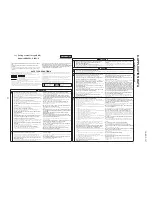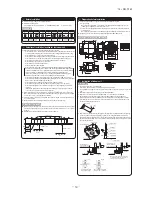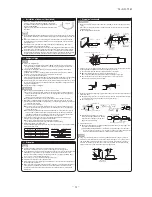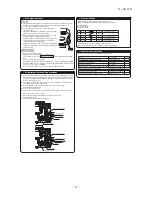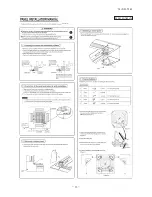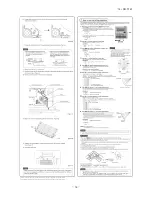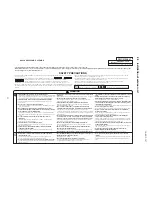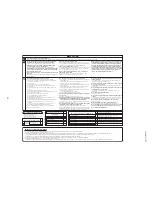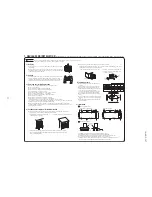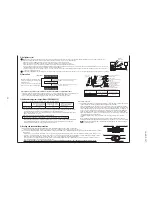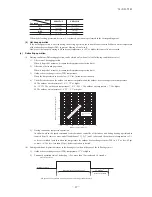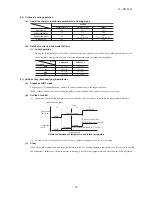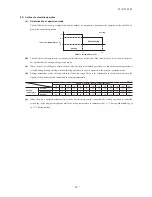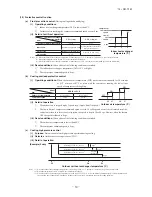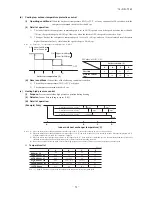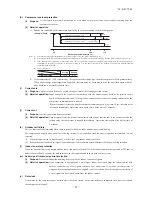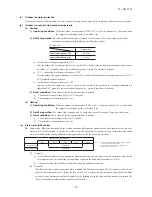
-
-
'14 • SR-T
-157
Wires for connecting indoor
and outdoor units
Exterior tape
Gas piping
Insulation
Liquid piping
Band (procured locally)
Pipe cover (procured locally)
8) Heating and condensation prevention
5) Air tightness test
Gas side
service valve
Check joint
Pressurize
Close
Outdoor unit
Indoor unit
<Work flow>
6) Evacuation
Pay attention to the following points in addition to the above for the R410A and compatible machines.
Air tightness test completed
Fill refrigerant
Vacuum gauge check
Vacuuming completed
Vacuuming begins
Although outdoor and indoor units themselves have been tested for air tightness at the factory, check the connecting pipes after the installation work for air tightness from the service
valve’s check joint equipped on the outdoor unit side. While conducting a test, keep the service valve shut all the time.
a) Raise the pressure to 0.5MPa, and then stop. Leave it for five minutes to see if the pressure drops.
b) Then raise the pressure to 1.5MPa, and stop. Leave it for five more minutes to see if the pressure drops.
c) Then raise the pressure to the specified level (4.15MPa), and record the ambient temperature and the pressure.
d) If no pressure drop is observed with an installation pressurized to the specified level and left for about one day, it is acceptable. When the ambient temperature fall 1
o
C, the pressure also
fall approximately 0.01MPa. The pressure, if changed, should be compensated for.
e) If a pressure drop is observed in checking e) and a) – d), a leak exists somewhere. Find a leak by applying bubble test liquid to welded parts and flare joints and repair it. After repair,
conduct an air tightness test again.
In conducting an air tightness test, use nitrogen gas and pressurize the system with nitrogen gas from the gas side. Do not use a medium other than nitrogen gas under any circumstances.
• To prevent a different oil from entering, assign dedicated tools, etc. to each refrigerant type. Under no circumstances must a
gauge manifold and a charge hose in particular be shared with other refrigerant types (R22, R407C, etc.).
• Use a counterflow prevention adapter to prevent vacuum pump oil from entering the refrigerant system.
• This
unit
contains factory charged refrigerant covering 15m of refrigerant piping and additional refrigerant charge on
the installation site is not required for an installation with up to 15m refrigerant piping.
When refrigerant piping exceeds 15m, additionally charge an amount calculated from the pipe length and the above
table for the portion in excess of 15m.
* When an additional charge volume calculation result is negative, it is not necessary to charge refrigerant additionally.
• For an installation measuring 15m or shorter in pipe length, please charge the refrigerant volume charged for
shipment at the factory, when you recharge refrigerant after servicing etc.
1
2
Run the vacuum pump for at least one hour after the vacuum
gauge shows –0.1MPa or lower. (–76cmHg or lower)
When the system has remaining moisture
inside or a leaky point, the vacuum gauge
indicator will rise.
Check the system for a leaky point and
then draw air to create a vacuum again.
Confirm that the vacuum gauge indicator does not rise even if
the system is left for one hour or more.
(Gas side)
Charge hose (Designed specifically for R410A)
Compound pressure gauge
Pressure gauge
Gauge manifold
(Designed specifically for R410A)
Handle Hi
Vacuum pump
Vacuum pump adapter
(Anti-reverse flow type)
(Designed specifically for R410A)
Charge hose
(Designed specifically for R410A)
Check joint
-0.1MPa
(-76cmHg)
Handle Lo
Service valve
Service valve
(Liquid side)
Service valve cap
Service valve cap
Service valve cap
tightening torque (N·m)
Check joint blind nut
tightening torque (N·m)
ø6.35 (1/4")
ø9.52 (3/8")
ø12.7 (1/2")
20
~
30
25
~
35
10
~
12
Service valve size
(mm)
Securely tighten the service valve cap and the check joint blind nut after adjustment.
(1) Dress refrigerant pipes (both gas and liquid pipes) for heat insulation and prevention of dew condensation.
• Improper heat insulation/anti-dew dressing can result in a water leak or dripping causing damage to household effects, etc.
(2) Use a heat insulating material that can withstand 120
o
C or a higher temperature. Poor heat insulating capacity can cause heat insulation problems or cable
deterioration.
• All gas pipes must be securely heat insulated in order to prevent damage from dripping water that comes from the condensation formed on them during a cooling
operation or personal injury from burns because their surface can reach quite a high temperature due to discharged gas flowing inside during a heating operation.
• Wrap indoor units’ flare joints with heat insulating parts (pipe cover) for heat insulation (both gas and liquid pipes).
• Give heat insulation to both gas and liquid side pipes. Bundle a heat insulating material and a pipe tightly together so that no gaps may be left between them and
wrap them together with a connecting cable by a dressing tape.
•
Both gas and liquid pipes need to be dressed with 20mm or thicker heat insulation materials above the ceiling where relative humidity exceeds 70%.
(1) Calculate a required refrigerant charge volume from the following table.
Formula to calculate the volume of additional refrigerant required
7) Additional refrigerant charge (Model SRC50/DXC18)
Additional charge volume (kg) = { Main length (m) – Factory charged volume 15 (m) } x 0.02 (kg/m)
5
1
5
3
.
1
2
0
.
0
Model SRC50/DXC18
Put down the refrigerant volume calculated from the pipe length onto the caution label attached
on the service panel.
• Since R410A refrigerant must be charged in the liquid phase, you should charge it, keeping the container
cylinder upside down or using a refrigerant cylinder equipped with a siphon tube.
• Charge refrigerant always from the liquid side service port with the service valve shut. When you find it
difficult to charge a required amount, fully open the outdoor unit valves on both liquid and gas sides and
charge refrigerant from the gas (suction) side service port, while running the unit in the cooling mode. In
doing so, care must be taken so that refrigerant may be discharged from the cylinder in the liquid phase
all the time. When the cylinder valve is throttled down or a dedicated conversion tool to change liquid
phase refrigerant into mist is used to protect the compressor, however, adjust charge conditions so that
refrigerant will gasify upon entering the unit.
• In charging refrigerant, always charge a calculated volume by using a scale to measure the charge
volume.
• When refrigerant is charged with the unit being run, complete a charge operation within 30minutes.
Running the unit with an insufficient quantity of refrigerant for a long time can cause a compressor failure.
(2) Charging refrigerant
NOTE
Additional charge volume (kg)
per meter of refrigerant piping
(liquid pipe ø6.35)
Refrigerant volume charged
for shipment at the factory
(kg)
Installation’s pipe length (m)
covered without additional
refrigerant charge

